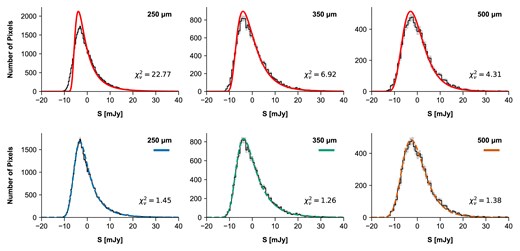2025-04-10 英国研究イノベーション機構(UKRI)
<関連情報>
- https://www.ukri.org/news/hidden-galaxies-could-answer-key-questions-about-our-universe/
- https://academic.oup.com/mnras/article/539/1/336/8108280
- https://academic.oup.com/mnras/article/539/1/347/8108279
Herschel-SPIREダークフィールドI:サブミリメートル宇宙の最も深いハーシェル画像 The Herschel-SPIRE Dark Field I: the deepest Herschel image of the submillimetre Universe
Chris Pearson, Thomas W O Varnish, Xinni Wu, David L Clements, Ayushi Parmar, Helen Davidge, Matthew Pearson
Monthly Notices of the Royal Astronomical Society Published:10 April 2025
DOI:https://doi.org/10.1093/mnras/staf335

ABSTRACT
We present the image maps, data reduction, analysis, and the first source counts from the Herschel SPIRE Dark Field. The SPIRE Dark Field is an area of sky near the North Ecliptic Pole observed many times during the calibration phase of the Herschel mission in order to characterize the stability of the SPIRE (Spectral and Photometric Imaging Receiver) instrument and is subsequently one of the deepest imaged fields of the Universe at far-infrared-submillimetre wavelengths. The SPIRE dark field is concurrent with the Spitzer Infrared Array Camera Dark Field used for a similar purpose. The final Dark Field map is comprised of 141 individual SPIRE observations in Small Map and Large Map modes defined by a deep inner region approximately 12 arcmin in diameter and a slightly shallower surrounding area of diameter∼30arcmin. The depth of both regions reach well below the confusion limit of the SPIRE instrument at 250, 350, and 500μm. Two independent processes are used to extract sources, a standard map based method using the SUSSEXtractor algorithm and a list driven photometry approach using the XID (cross identification) algorithm with the Spitzer MIPS (Multiband Imaging Photometer for Spitzer) 24μm catalogue as an input prior. The resulting source counts detect the turnover in the galaxy population with both methods shown to be consistent with previous results from other Herschel surveys, with the XID process reaching approximately twice as deep compared to traditional map based algorithms. Finally, we compare our results with two contemporary galaxy evolution models, again showing a good general agreement with the modelled counts.
Herschel-SPIREダークフィールド – II. サブミリメートル宇宙の最深部ハーシェル像のP(D)揺らぎ解析 The Herschel-SPIRE Dark Field – II. A P(D) fluctuation analysis of the deepest Herschel image of the submillimetre universe
Thomas W O Varnish, Xinni Wu, Chris Pearson, David L Clements, Ayushi Parmar
Monthly Notices of the Royal Astronomical Society Published:10 April 2025
DOI:https://doi.org/10.1093/mnras/staf318

ABSTRACT
The Herschel-SPIRE Dark Field is the deepest field produced by the SPIRE instrument pushing down below the galaxy confusion limit in each of the 250, 350, 500 μm bands. Standard source extraction techniques inevitably fail because of this, and we must turn to statistical methods. Here, we present a P(D) – probability of deflection – analysis of a 12′ diameter region of uniform coverage at the centre of the Herschel-SPIRE Dark Field. Comparing the distribution of pixel fluxes from our observations to the distributions predicted by current literature models, we find that none of the most recent models can accurately recreate our observations. Using a P(D) analysis, we produce a fitted differential source count spline with a bump in the source counts at faint flux densities, followed by a turnover at fainter fluxes, required to fit the observations. This indicates a possible missing component from the current literature models that could be interpreted perhaps as a new population of galaxies, or a missing aspect of galaxy evolution. Taking our best-fitting results, we also calculate the contribution to the cosmic infrared background (CIB) in each of the bands, which all agree with the Planck CIB measurements in this field.



